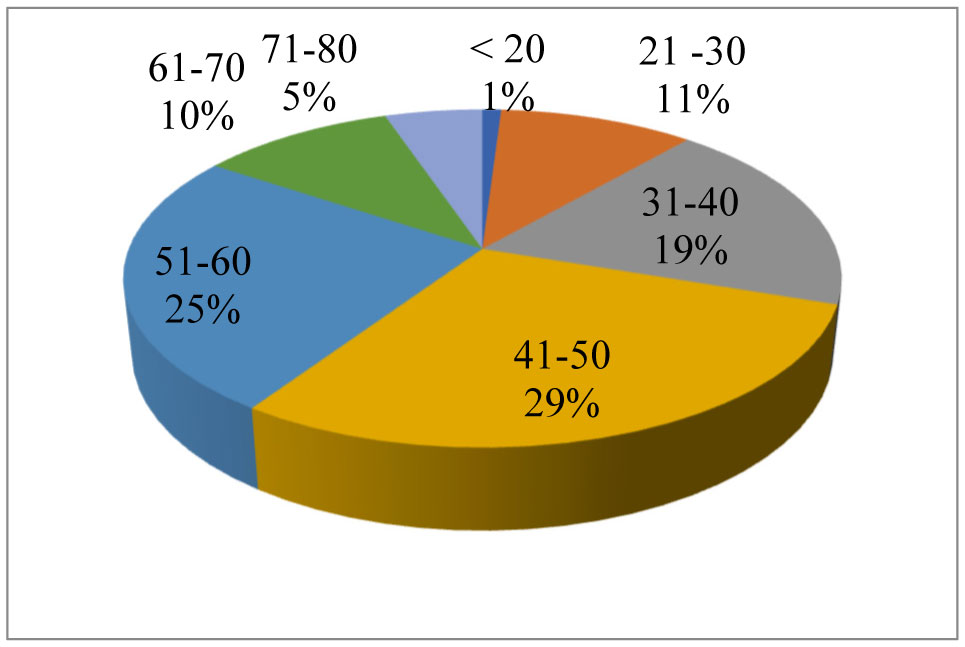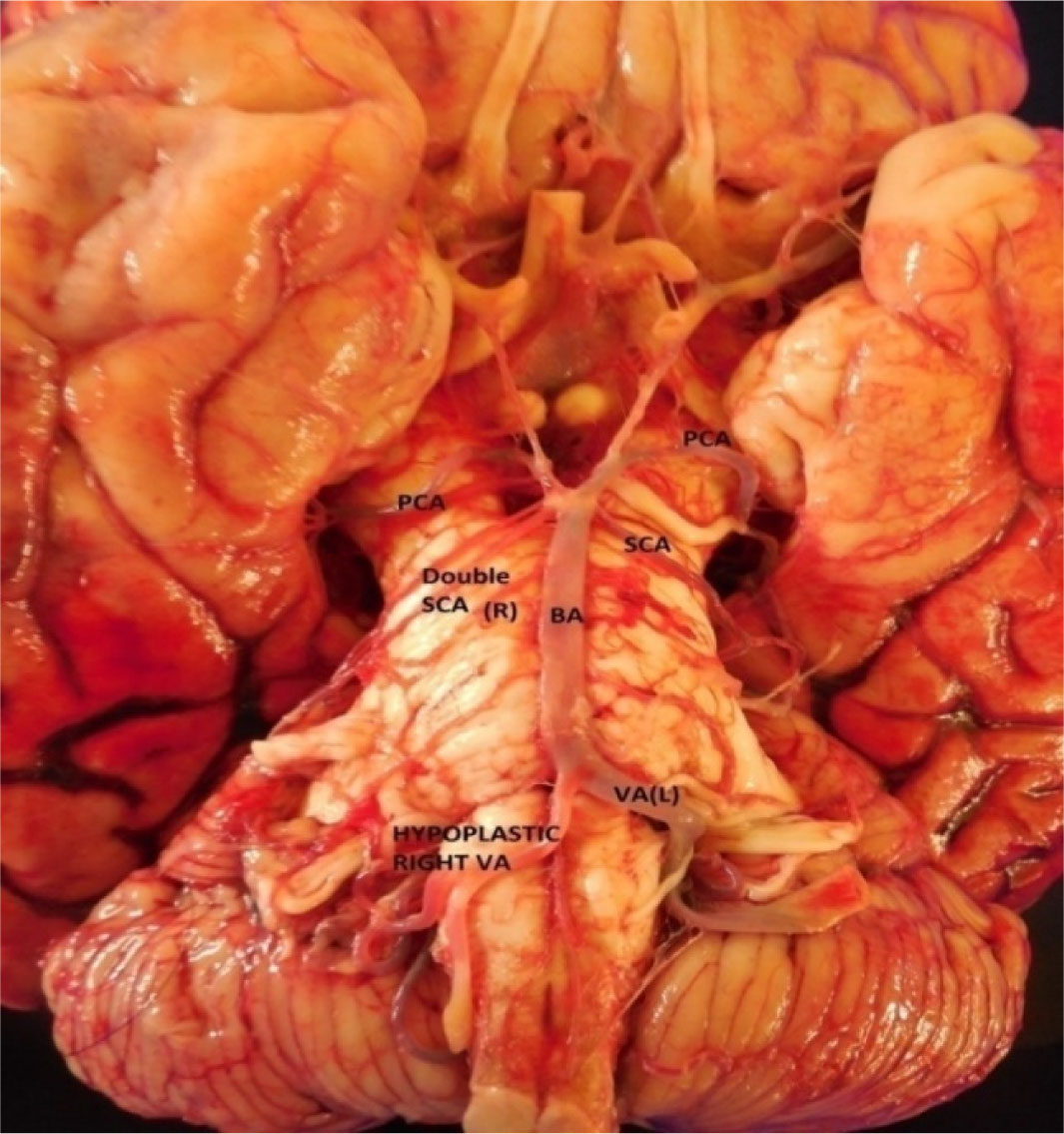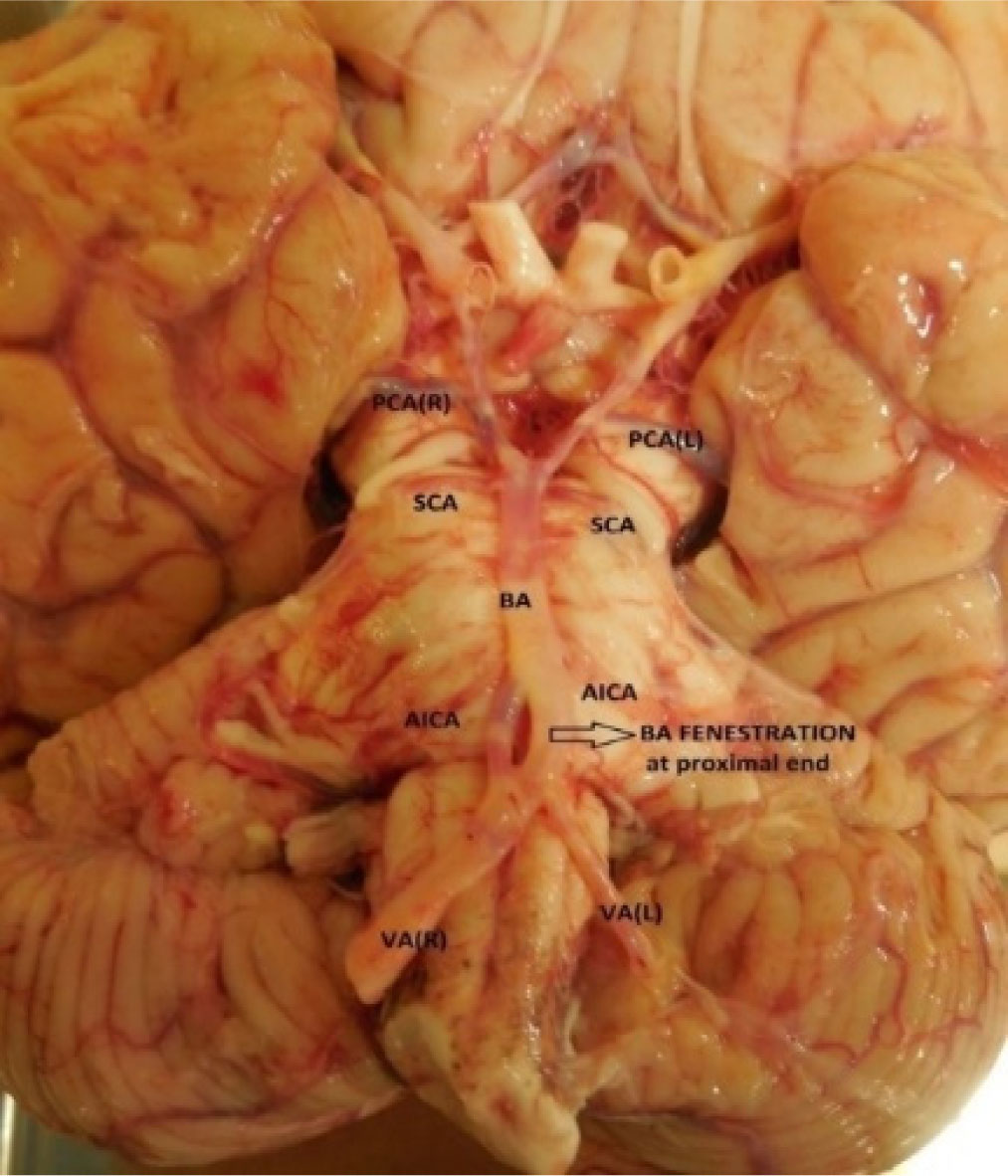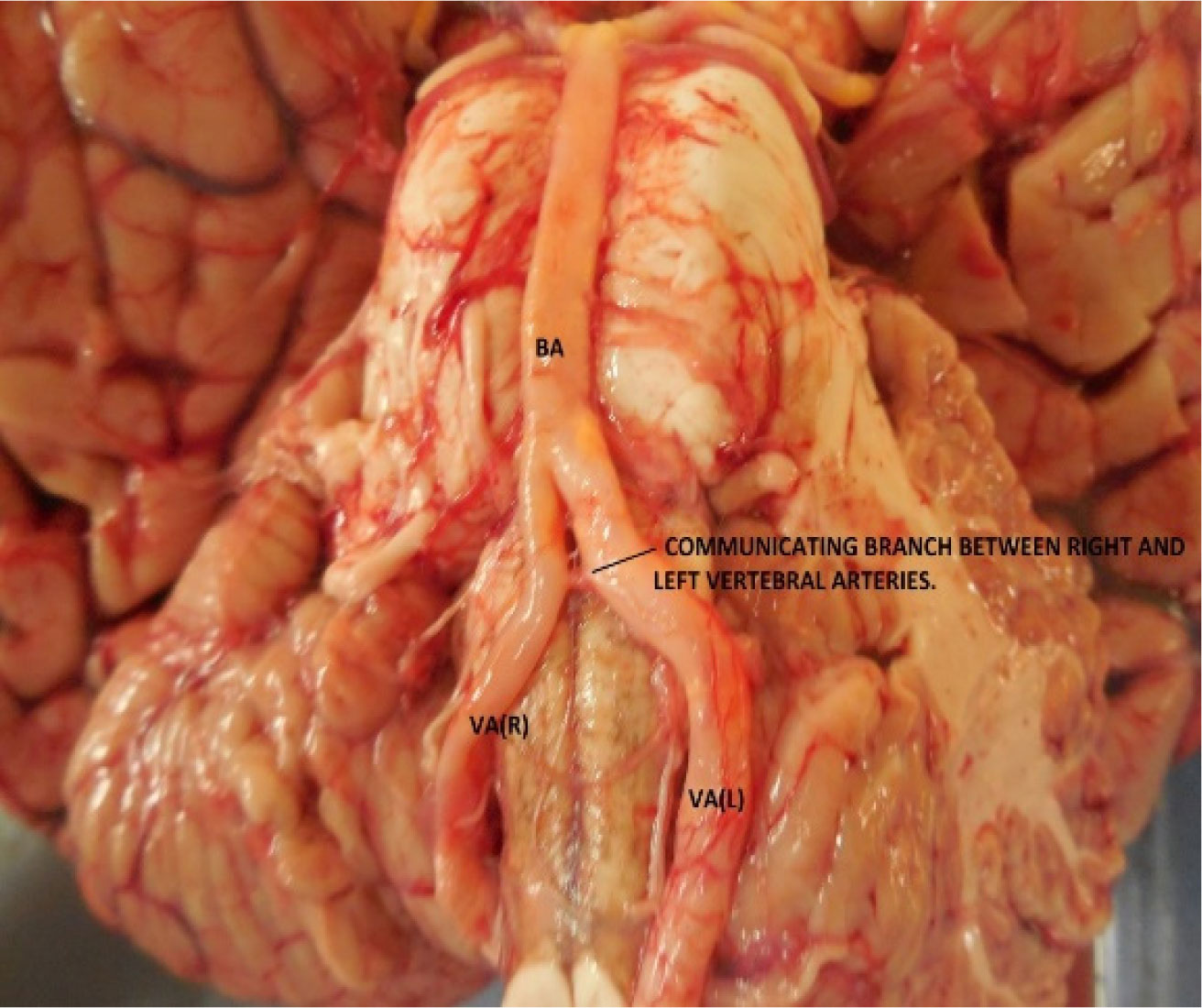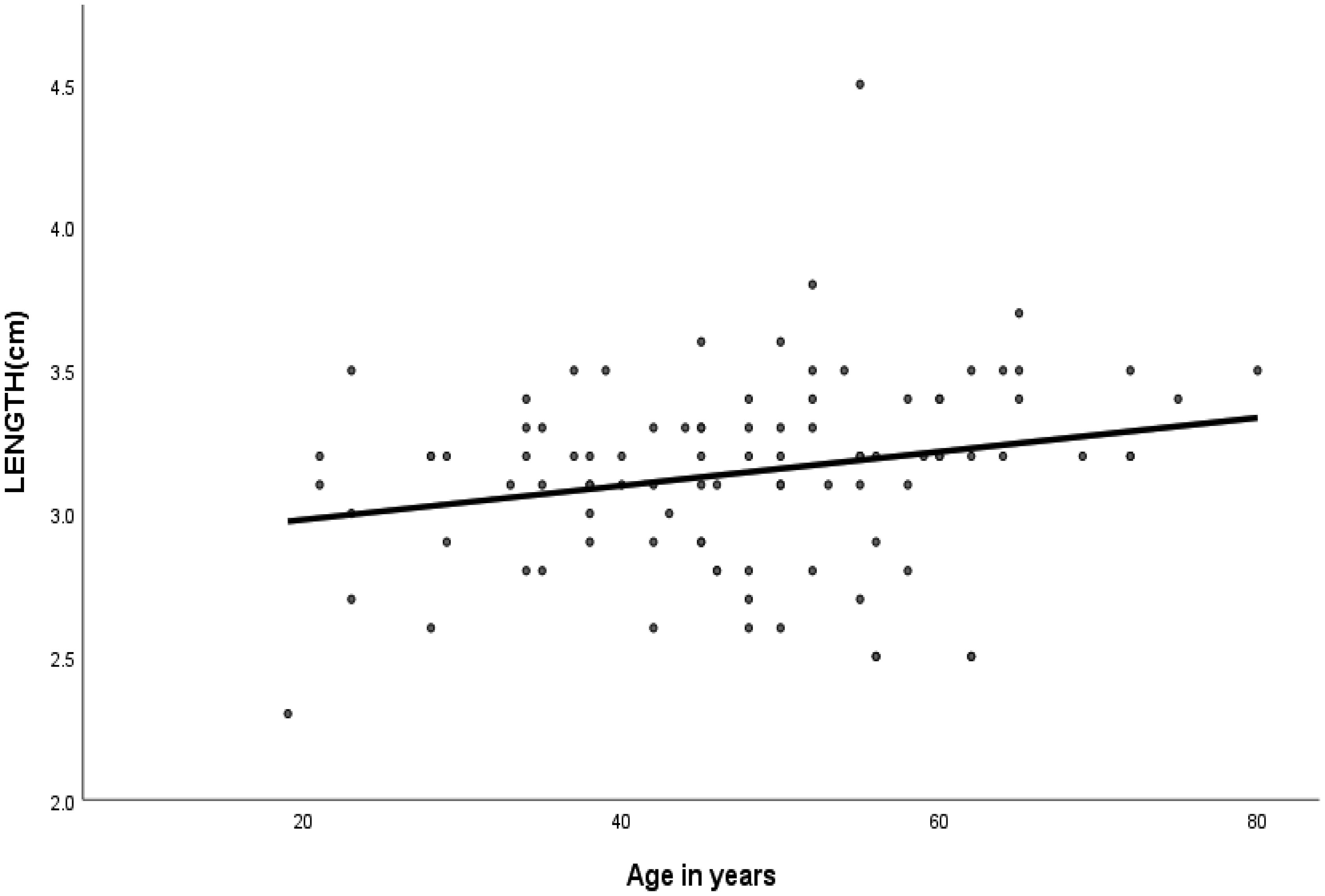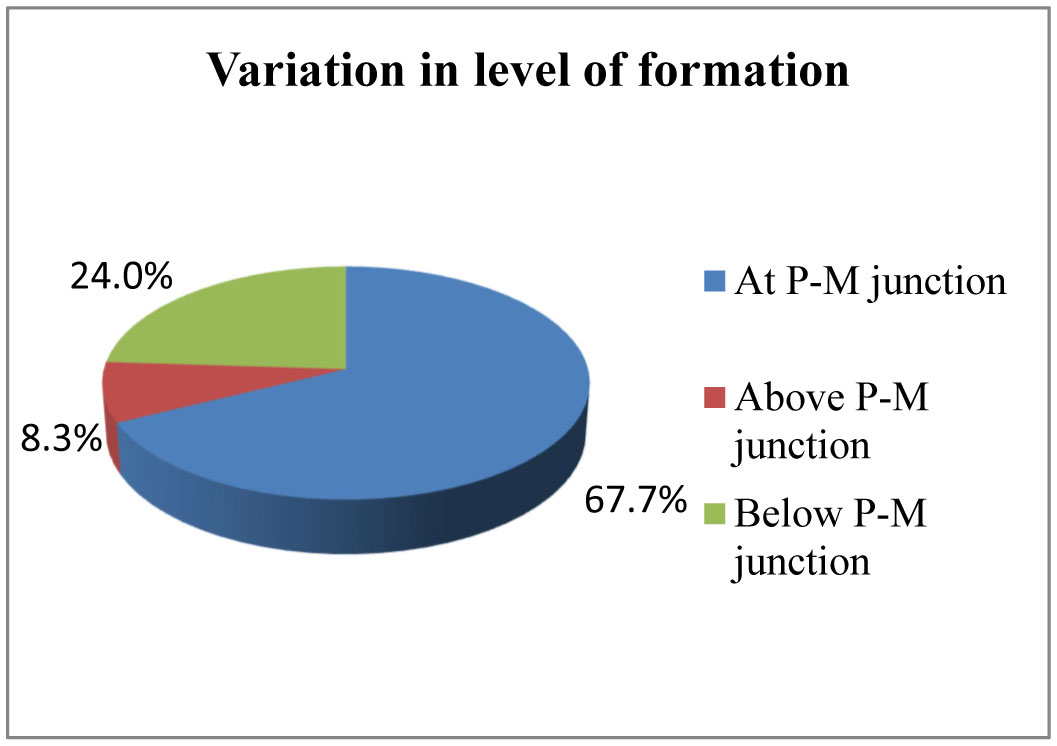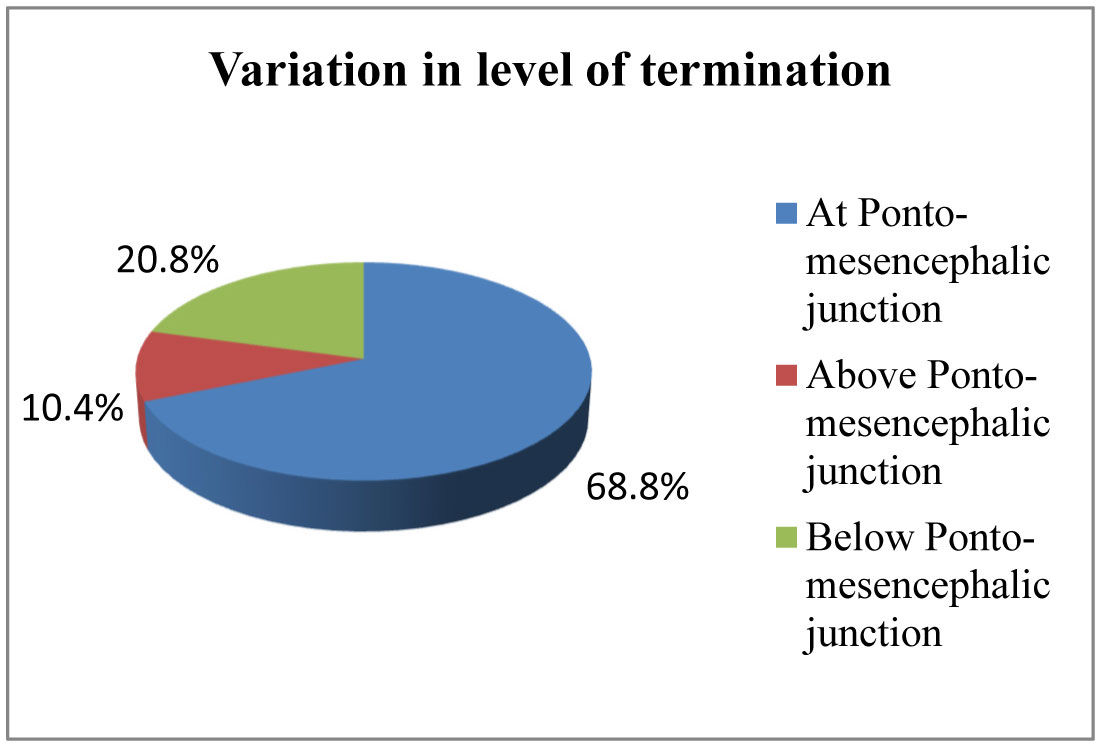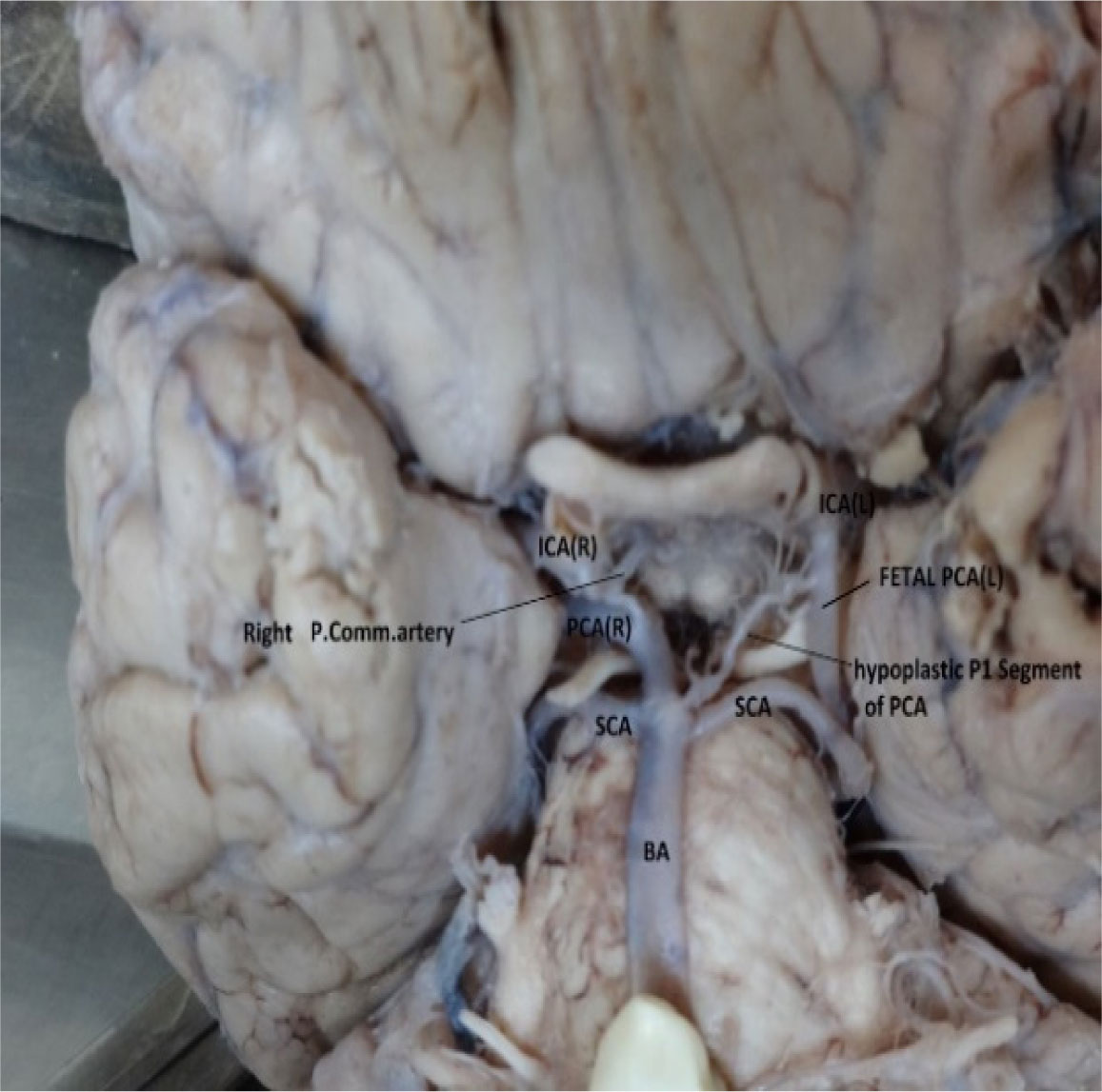Introduction
Basilar artery is an unpaired medium-sized artery formed by the confluence of right and left vertebral arteries at the pontomedullary junction and extends to the pontomesencephalic junction. It forms the spine of posterior cerebral circulation which is constituted by the vertebrobasilar system and its branches. Normal morphology of the basilar artery forms an essential component of cerebral circulation. The present study aims to measure the level of formation & termination, length, diameter, and angle of formation of the basilar artery. The data presented are relevant to understanding human variations and would be a good anatomical reference for clinicians, anatomists, and medical students. Caliber, length, and angle of bifurcation of the basilar artery help in assessing the feasibility and approach for various surgical procedures and predict cerebro-vascular diseases.
Materials & methods
96 adult human brain specimens were studied. (78 male, 18 female) (Age range: 19–80 y; Average age: 47.66 y). Measurements were taken using Vernier calliper. Data was analysed using Microsoft Excel and SPSS software version 17.
Results
The basilar artery was formed by the confluence of two vertebral arteries in all specimens extending from the pontomedullary junction to the pontomesencephalic junction in 2/3rd of the cases. The left vertebral artery was found to be dominant in 62.5% specimens. The basilar artery showed an average length of 3.1 cm (demonstrating positive correlation with age), average diameter of 3.6–3.9 mm at different levels, and average angle of formation as 65.38° in males and 62.22° in females. Fetal type posterior cerebral artery was noticed in 9.4% cases. 3.1% and 6.3% cases were seen on the right and left sides respectively. Basilar artery fenestration was noted in 2 percent specimens.
Conclusion
Basilar artery morphology was studied in 96 human adult cadavers. Basilar artery formation and termination was normal in more than 2/3rd cases. Variations were noted in its origin, vessel hypoplasia, presence of fenestrations, and fetal patterns. The data obtained from this study are relevant for anatomists, medical students, interventional radiologists, and neurosurgeons.
1.
Introduction
The basilar artery is an unpaired medium sized vessel formed by the confluence of two vertebral arteries at the pontomedullary junction and extends to the upper border of pons where it divides into two posterior cerebral arteries at a variable level usually in the interpeduncular cistern [1]. It forms the spine of posterior cerebral circulation which is constituted by the vertebrobasilar system and its branches.
Normal morphology of basilar artery forms an essential component of cerebral circulation (Figure 1). It is complex and variable. The objectives of the present study are to describe the formation & termination of the basilar artery with its variations, angle of formation, length, and diameter of the basilar artery. Knowledge of these normal parameters are essential to design, select, and to mold devices during interventional neuroradiological procedures. It would also help to alleviate complications of endovascular treatment during diagnostic, surgical, and interventional radiological procedures [2]. Geometric features of basilar artery influence the occurrence of atherosclerosis and aneurysms [3]. Variations may compromise vertebrobasilar system output and can predispose patients to posterior circulation stroke.
The level of confluence of the vertebral arteries to form the basilar artery is important during basilar artery instrumentation. Angle of formation is important while approaching for endovascular coiling. Large angles of confluence are said to be geometric risk factors for atherosclerosis [4]. Height of basilar artery bifurcation whether it is high or low in relation to dorsum sellae is an important consideration in selecting a surgical approach for basilar bifurcation aneurysms. Length and diameter of basilar artery are important for endovascular procedures. Average diameters are significantly higher in patients with aneurysms. Diameter measurements can solely help in predicting the risk of cerebrovascular and cardiovascular diseases [5]. Basilar artery diameter may be associated with neurological deterioration in acute pontine infarction [6]. Datas obtained from this study would be a good anatomical reference for clinicians, anatomists, and medical students.
Most anomalies of vertebrobasilar system arise due to early embryonic developmental deteriorations. Basilar artery forms by approximately fifth fetal week, i.e. during 5–8 mm embryonic stage by the fusion of two longitudinal neural arteries. Midline fusion occurs from the caudal end upwards [7]. The incomplete fusion of two longitudinal vascular channels may result in the formation of basilar artery fenestration. Proximal basilar artery fenestration is more common.
In fetal variant of posterior circle of Willis, there is an embryonic derivation of the posterior cerebral artery from the internal carotid artery. In this case a larger area of brain is dependent on the internal carotid artery. Both the middle and posterior cerebral arteries are connected to the internal carotid system rather than the vertebrobasilar system. Tentorium prevents cerebellar vessels from connecting to the posterior cerebellar artery territory. As a result, the leptomeningeal collaterals fail to get established between carotid and vertebrobasilar systems. This increase the risk for stroke in subjects with fetal type posterior cerebral artery [7],[8].
2.
Materials and methods
Basilar arteries were studied in ninety-six (78 male; 18 female) adult human brain specimens obtained from the Forensic Medicine & Anatomy Departments of Govt. Medical College, Thiruvananthapuram after obtaining Research Committee and Ethical Committee approval. (Age range: 19–80 y; Average age: 47.66 y). Duration of study was 1.5 years. The dissection steps followed for whole brain removal was as per Cunningham's manual of practical anatomy [9]. The brain was washed in running water. The meningeal coverings over the brainstem and interpeduncular cistern were removed carefully, exposing the vertebral and basilar arteries along with posterior part of the circle of Willis. Vessels examined thoroughly in situ, and sketches were made if any variations were noticed. Vernier calipers (with a smallest count of 0.01 mm) was used to measure the dimensions. A ruler was used to calculate the length of basilar artery. Measurement was taken from a point where the two vertebral arteries united to form the vessel. Terminal point was taken at the site where basilar artery bifurcated to form the right and left posterior cerebral arteries. The outer diameters of the artery at the level of formation, midlevel, and termination were noted in mm using vernier calipers. The angle of formation in degrees was measured using a protractor. After studying the specimens thoroughly, areas of interest were mopped using filter paper. Post-mortem brains with variations were photographed in situ. Data was analyzed using Microsoft Excel and SPSS software version 17.
2.1. Inclusion criteria
Apparently normal human adult brain specimens available during the period of study.
2.2. Exclusion criteria
1. Cases with history/finding of intracranial injuries.
2. Decomposed bodies
3. Fetal/ infant autopsies
3.
Results
A total number of 96 human adult cadaveric brain specimens were studied by dissection. The variation in origin of the basilar artery, level of formation & termination, length, angle of formation, outer diameters at origin, midlevel and termination were analyzed.
3.1. Age distribution
Among 96 human brain specimens, one specimen belonged to below 20 age group. 10 specimens were from age group 21–30. 18 specimens were from 31–40 age group. 28 specimens were from 41–50 age group. 24 specimens belonged to 51–60 age group. In 61–70 age group, 10 specimens were present. Between 71–80 age group, 5 specimens were present (Figure 2).
Gender distribution: 78 (81.3%) specimens belonged to male & 18 (18.8%) belonged to female cadavers.
Angle of formation of the basilar artery ranged from 50 to 90 degrees. Mean angle of formation was 64.8 degrees. A box plot diagram showing angle of formation is given in Figure 3.
Basilar artery is formed by the union of right and left vertebral arteries. Variations in origin of the basilar artery is depicted in Table 1 given below.
Figue 4, 5 & 6 depicts variations noticed in the origin of the basilar artery.
3.2. Mean length of basilar artery
Out of 96 specimen studied basilar artery had a mean length of 3.1 cm (31 mm) demonstrating positive correlation between age and length of basilar artery. Pearson Correlation r = 0.240 (p value = 0.019).
There was positive correlation between age of cadavers and length of basilar artery (p < 0.05) as shown in Figure 7. As age advances basilar artery length increases.
3.3. Outer diameter
Among 96 specimens, the average diameter of basilar artery at the level of origin was 3.7 mm and ranged from 2–5 mm. Outer diameter at the midlevel was 3.6 mm and ranged from 2–5 mm. At the level of termination, it was 3.9 mm and it ranged from 2–5 mm.
3.4. Level of formation & termination of basilar artery
In 65 (67.7%) specimens, level of basilar artery formation was observed at the pontomedullary junction. Level of termination was at the ponto-mesencephalic junction in 66 (68.8%) specimens. Variations are depicted in Figure 8 & 9.
Basilar artery fenestration was seen in 2 cases (2%) out of 96 specimens. The word fenestration refers to a localized or segmental duplication equally to an unfused vessel (Figure 5).
Fetal type posterior cerebral artery (Figure 10) noted in 9.4% cases. 3.1% and 6.3% cases were noticed on the right side and left side respectively. In fetal variant of posterior circle of Willis, there is an embryonic derivation of the posterior cerebral artery from the internal carotid system.
4.
Discussion
In the present study, the left vertebral artery was found to be dominant in 62.5% specimens. Right vertebral artery was dominant in 12.5% cases and both were of equal size in 18.8% specimens. Hypoplasia of the right and left vertebral arteries were noted in 3.1% cases each. The present study is comparable to studies done by Padmavathi G [10] and Yasargil [11] et al. Hypoplastic vessels were frequently associated with vertebro-basilar territory ischemic stroke. An external diameter of ≤2 mm is considered to be hypoplastic [12]. Unequal vertebral artery flow is a haemodynamic contributor of the basilar artery curvature and development of perivertebrobasilar junctional infarct [13].
Tables 2 and 3 compares the present study with various authors in terms of the level of formation and the level of termination of basilar artery.
Angle of fusion between the two vertebral arteries was found to vary between 45°–70° (mean value: 60 ± 8.7°) in a study by Mamatha et al. [14]. Padmavathi et al. [10] found it to range between 50° and 90°. Pai et al. [17] found that the angle of formation of basilar artery ranged between 40°–80° (mean value: 51°). In present study, the angle of formation of basilar artery ranged from 50° to 90° with a mean value of 64.8°. Angle of confluence plays an important role in the location of atherosclerosis [18]. Basilar artery geometry strongly influences skewing of velocity profiles, wall shear stress distribution, and progression of atherosclerosis [19].
In the present study, the basilar artery length ranged from 2.3–4.0 cm with a mean length of 3.1 cm. Comparison of length of the basilar artery measured by various authors is summarized in Table 4. A positive correlation was obtained between the age of cadavers and the length of basilar artery (p < 0.05) in this study. As the age advances basilar artery length increases. Variations in length and position of basilar artery can be attributed to ageing and hemodynamic factors [14]. Studies on patients with history of stroke showed atherosclerotic changes of the posterior circulation and a higher degree of vertical elongation of the BA. Severe ectasia and vertical elongation of the BA were significantly more often observed in patients with infarcts in PCA territory [20]. Patients with elongated and tortuous basilar arteries tend to have isolated cranial nerve involvement, whereas patients with dilatation (ectasia) of the basilar artery suffer from multiple neurologic deficits. Because the basilar artery parameters and neurologic symptoms present as a spectrum, this entity is referred to as the vertebrobasilar dolichoectasia (VBD). The pathogenesis of VBD is most likely caused by marked thinning or absence of the internal elastic lamina, thinning of tunica media secondary to smooth muscle atrophy, and hyalinization of connective tissue [21]. Since the elastic lamina is prominent in resisting the expansile effects of systolic blood pressure, prolonged systemic arterial hypertension may cause vessel dilatation and elongation [22].
Padmavathi et al. [10] noted that the diameter at origin, midlevel and termination were 4.5 mm, 4 mm, and 4.8 mm. Pai et al. [17] studied 25 specimens and in their study the diameter of basilar artery ranged from 3 to 7 mm with a mean value of 4.3 mm. Iqbal S [15] noted that the mean diameter of basilar artery was 3.9 mm and it ranged between 2.8 to 5.1 mm. Harish A Wankhede [16] noted that the diameter of basilar artery at origin, midlevel, and termination were 3.63 +/− 0.22, 3.53 +/− 0.22 and 3.6 +/− 0.22. In this study, the diameter at origin, midlevel, and termination were found to be 3.7 mm, 3.6 mm, and 3.9 mm respectively (Table 5).
Increase in basilar artery diameter increase the risk of cerebrovascular events by 1.55 [5]. Ectasia is diagnosed when basilar artery diameter is greater than 4.5 mm. Dolichoectasia suggests a higher propensity to atherosclerotic disease. Basilar artery diameter >4.5 mm may be a marker for a high risk of fatal stroke [25]. Diameters are also important in the designs of catheters for interventional neuroradiology.
Basilar artery fenestration was seen in 2 cases (2%) out of 96 specimens (Figure 5). Black SP et al. [26] mentions about an endothelium -lined partial intraluminal septa within the fenestrated artery. Such spurs could be points of turbulence and initial sites for potential thrombosis. The tunica media is absent locally, elastin being continuous at the proximal end of fenestration. The subendothelium is thinned proximally, but thickened distally. This explains the increased incidence of aneurysms with fenestration [27].
In fetal variant of the posterior cerebral artery, there is an embryonic origin of the posterior cerebral artery from the internal carotid system. In this study, the fetal type of posterior cerebral artery was noticed in 9.4% subjects. 3.1% cases were right sided and 6.3% cases were left sided (Figure 10). Stopford [28] noted the fetal posterior cerebral artery in 10% of cases. 5% cases were noticed on the right and 3% cases were on the left side. 2% cases were noticed bilaterally.
We acknowledge that this study has limitations. We expect postmortem changes in all parameters measured. This should be kept in mind while referring the data obtained from this study.
5.
Conclusion
This study done on 96 human adult cadaveric brain specimens provides information regarding the morphology of human basilar artery in terms of its length, diameter, angle of formation, level of formation and termination and its variations. Basilar artery formation and termination was normal in more than 2/3rd cases. Basilar artery showed an average length of 3.1 cm (demonstrating positive correlation with age), average diameter of 3.6–3.9 mm at different levels, and average angle of formation as 65.38° in males and 62.22° in females. Basilar artery fenestration and fetal posterior cerebral artery were discussed. The data obtained from this study are anatomical reference for clinicians, anatomists and students. The study is relevant not only for interventional radiologist but also for neurosurgeons who perform surgeries in the posterior cranial fossa for various pathologies such as aneurysms, A-V malformations, tumours etc and also while performing vascular bypass and shunt procedures. Anticipation of variations may prevent inadvertent trauma and confusion during surgery.
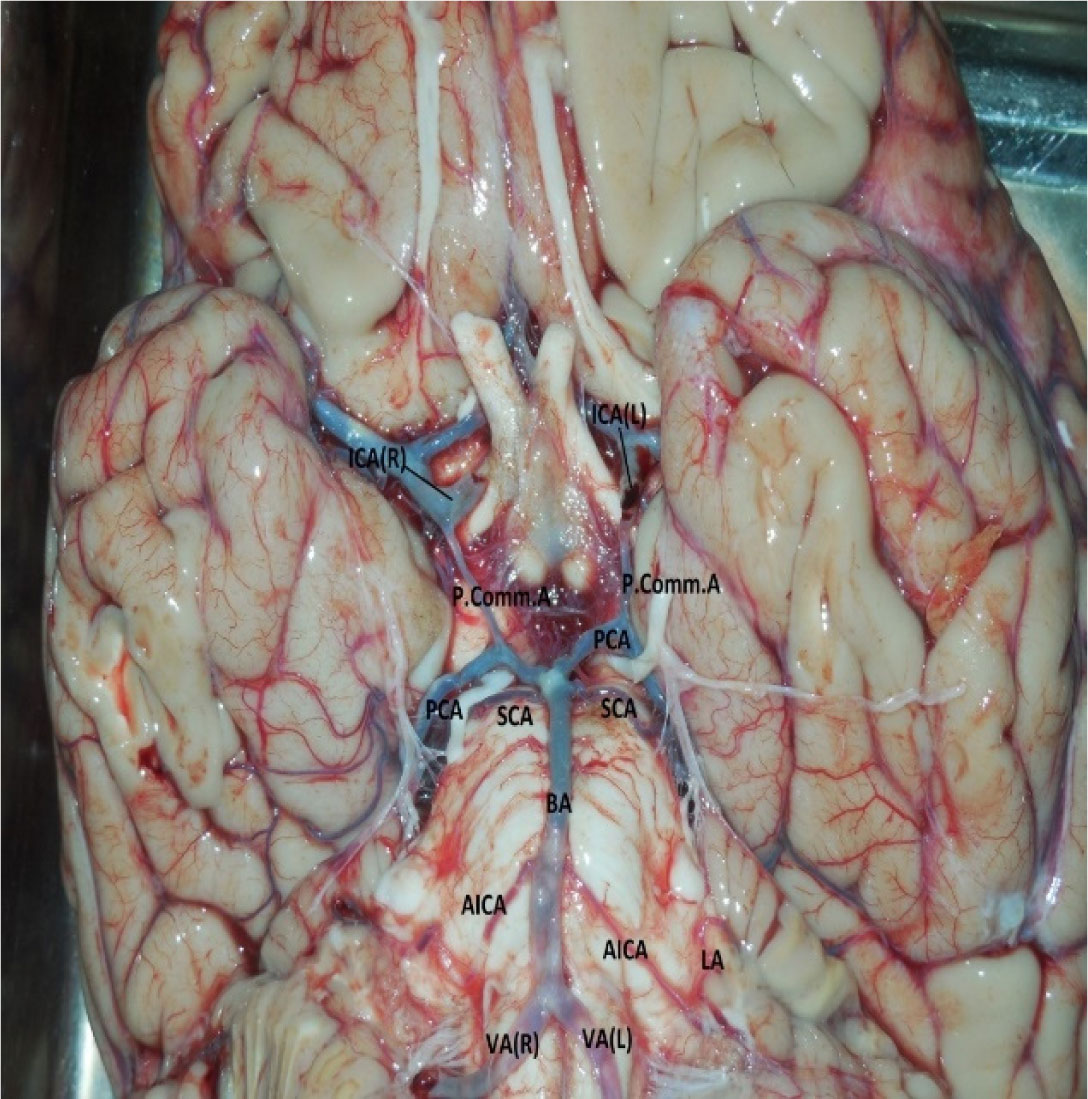









 DownLoad:
DownLoad:
